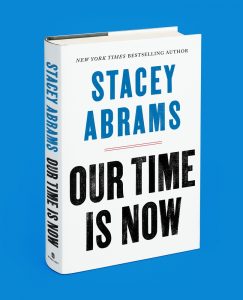Stacey Abrams on the Urgency of Voter Registration
And How It Became a Focus of Her Political Career
My favorite speech by Dr. Martin Luther King is not his extraordinary “I Have a Dream” delivered at the 1963 March on Washington. I actually prefer his lesser-known 1966 speech delivered in Kingstree, South Carolina, where his audience gathered in folding chairs and he addressed listeners from a makeshift podium, asking them to “March on Ballot Boxes.” On a damp Mother’s Day morning, the almost entirely black gathering heard him lay out his case, arguing that the ability to change the legislative agenda—and by extension their very lives—began with registering to vote. Like a golden ticket, the act of voter registration opens the process of democracy, and without it, citizens are just aspirants at the gate. His rhetorical flourish hammered home an essential truth: regardless of the constitutional amendments ratified and the electoral laws passed, the point of entry into the process of participation rests solely on being among those allowed to write their names on the rolls. Dr. King understood this and he challenged the audience to register at least ten other people before the upcoming primary.
Growing up, my parents ensured that my siblings and I understood the critical nature of registration. Beyond my father’s own arrest for encouraging eligible black men and women to sign up, I had my own personal experiences with the issue of registration. In 1991, I enrolled at Spelman College, part of the Atlanta University Center. The AUC, as it is known, contained four historically black colleges and universities, as well as a medical school and a school of theology, also historically black. I was a freshman in college there when I turned 18, and my greatest excitement came from being able to register to vote.
By the fall of 1992, I spearheaded a voter registration drive at the AUC to sign up black students across the campuses. That summer, Democrats had nominated Arkansas governor Bill Clinton, and his running mate was the senator from Tennessee, Al Gore. The Gulf War had ended in early 1991, but the incumbent Republican president grappled with a failing economy, rising health care costs, and the angst of young voters and voters of color who felt unseen and unheard. I eagerly canvassed dorms and stood in Manley Plaza on Spelman’s campus, begging my fellow students to sign up.
The national excitement of the election eased the process, but getting students to sign up still proved to be a slog. I remember more than one conversation about why someone should care or why they thought the game was rigged. In response, I would often invoke the Rodney King decision, arguing how things might have been different if the jury looked more like the community where he lived. I talked about the violence and the poverty that existed in the housing projects just outside our college gates. Sometimes it worked, but usually it did not. Still, I kept begging for sign-ups and thus began my voting rights fight that has never ended.
While it has been at the forefront of my mind for most of my life, for most Americans, the issue of voter registration—the point of entry into our electoral process—rarely crosses their minds. Communities with a history of easy participation often take for granted the civic system’s accessibility and relative ease. In seventeen states plus the District of Columbia, voter registration occurs automatically, typically through the state’s Department of Motor Vehicles (DMV). In almost every other state, registration when you get your license is an option because of the Voter Registration Act. More commonly referred to as the Motor Voter Act, Congress passed this law in 1993, as my efforts to register voters in the AUC were under way. The Motor Voter Act required states to offer eligible citizens the option to register to vote when applying for or renewing a license at the DMV or when interacting with other state agencies.
But, as was clear to me on a college campus in the middle of an economically depressed area of Atlanta, what seemed like a catchall for voter registration suffered from some major flaws. First, while most states use the DMV process, not every eligible citizen drives or has a driver’s license. This is even more true now than it was in the early 1990s: in the past few decades, the percentage of licensed drivers has dropped, particularly among the younger generations. Those who live in densely urbanized areas with public transit have less reason to drive, and then there are those areas where the residents simply can’t afford to own a car. These populations, which often intersect with the hardest-to-register groups—poor people, rural populations, or people of color—do not universally benefit from motor-voter sign-ups. They may also be from communities where access to the DMV or a voter registration agency is simply more difficult.
Take, for example, the brief skirmish in Alabama in 2015, when the state proposed the closure of thirty-one driver’s license offices across the state. As a result of the proposed closures, eight out of the fourteen counties in the only majority-minority district in the state would not have had a DMV location.
Major monkey wrenches are obstructing the ability to process the applications of new voters in a timely manner and creating a system that is opaque and confusing.Overall, the Motor Voter Act continues to fall short of its aims because it targets only a select clientele for registration. Organizations like Demos and the Lawyers’ Committee for Civil Rights Under Law have been litigating compliance cases for years, with good reason. In the United States, groups with historical disenfranchisement either have limited access to the voter registration process or do not trust the process. In other nations, voter registration is automatic and the responsibility of the government, a system followed by most European democracies as well as countries like Peru and Indonesia.
The United States is one of the few democratized, industrialized nations that uses the piecemeal, inconsistent, state-by-state method of registration—and that puts the onus on the citizen to get on the rolls. With the management of elections left to individual states, the fractured, disjointed process is key to voter suppression. Where registration is easier, voters are more likely to participate.
When I ran for the Georgia House of Representatives in 2006, voter registration was a part of our campaign strategy. Then, in 2010, I became Georgia House Democratic Leader following an election where Democrats lost big at every level of government. I spent my first few years in my post trying to block Republicans from controlling a two-thirds majority in the House, which they already held in the Senate, in addition to their absolute control of the executive branch. I gave almost as much time to traveling the state, getting to know the members of my caucus and the people they served. As my attention focused on the insular world of political fisticuffs, voter registration receded as a goal. I left that work to others, my eyes focused narrowly on turning out the voters already on the rolls. Get them to vote at full strength and the rest would follow, I thought.
The danger of my shifting attention would become clear in 2013, during the implementation of the Affordable Care Act, President Obama’s long-awaited health care plan to cover the uninsured. As we worked to ensure that Georgia’s most vulnerable citizens had access to affordable health care, Dr. King’s lessons about the importance of voter registration became more salient than ever. For as poor Georgians would soon see, regardless of the passage of the Affordable Care Act, the point of entry for Georgians in need of health care rested heavily on the ability to sign up and be counted as voters.
As part of the rollout, states received generous allocations of dollars to fund navigators, trained personnel deployed to neighborhoods to explain how to traverse the complex system of health insurance that would now require mandatory compliance. In Georgia, the issue was particularly acute: the state had one of the highest uninsured rates in the nation. Every state participates in Medicaid, the low-income health care program that shares costs between the states and the federal government. Because the program is primarily administered by the states, qualification differs based on where you live.
In Georgia, Medicaid does not cover low-income childless adults, regardless of their poverty level; and it only covers working parents who make less than 50 percent of the federal poverty level or approximately $9,765 a year for a family of three in 2013. With one of the most restrictive policies in the nation, those of us who had been agitating for better health policy cheered when the Affordable Care Act plans included coverage for the working poor through the Medicaid expansion program.
However, the governor of Georgia rejected the funds for Medicaid expansion, like many other Republican governors. Health care advocates had braced ourselves for this decision. Then the state took a step few of us anticipated: it joined with a handful of states to make becoming a navigator nearly impossible beyond the limited federal program by imposing additional costs and licensure requirements few could meet. Despite the governor’s animosity to the Affordable Care Act, I had not imagined he would also object to educating citizens about a way to gain health insurance and possibly save their lives.
I’d been to Hancock County, where the loss of their hospital meant folks who had strokes there were more likely to die than in towns with their own hospitals. More than once, I had traveled to Stewart and Calhoun Counties where the loss of the local hospitals had cost jobs in areas where more than half the population would be eligible for Medicaid expansion or the Affordable Care Act. We’d run candidates in the most impoverished swath of Georgia, where the population was mostly black and the hospitals and doctors had disappeared. Without navigators or Medicaid expansion, the Affordable Care Act functionally did not exist.
In response, I launched a program called the New Georgia Project, my attempt to correct for the governor’s decision to block access to vital information in our most desperate areas. The New Georgia Project (referred to as the New Georgia Project–Affordable Care Act) would step into the gap and help poor Georgians learn about health insurance. We would train teams of low-income rural South Georgia community members to explain the new health insurance enrollment opportunities available through the Affordable Care Act. The New Georgia Project–Affordable Care Act existed to explain health insurance to families who’d never had the option before. We hired local community members to knock on more than twenty thousand doors and make more than 180,000 phone calls.
It worked. The Obama administration had estimated how many Georgians would sign up for health care through the Affordable Care Act, based on the size and poverty of our state’s population. Through our work, we increased anticipated sign-up rates and received recognition from President Obama’s administration for our efforts. But beneath our success lurked a darker reality. Nearly 600,000 Georgians were ineligible for the Affordable Care Act marketplace; they could only receive health care via the expansion of Medicaid. That meant that even in places like Calhoun County, where the poverty rate hovered at around 30 percent, health care remained out of reach. I met a middle-aged man who worked in a chicken processing plant. He’d heard about the new health care law and was eager to sign up. But his salary fell below the threshold to participate in the Affordable Care Act marketplace. The federal law anticipated this and, instead of ignoring him, made provisions for people like him to gain coverage under the existing Medicaid program. In theory, Medicaid expansion would guarantee him coverage as well. But not in Georgia.
The toolbox for effective disenfranchisement includes demonizing and blocking third-party registration of new voters.As our teams made contact, we heard a constant question: why didn’t President Obama want Georgians to have Medicaid? The canvassers had been trained to answer that Medicaid expansion was a state decision, not federal. The governor and conservative state legislators had refused the funding, not President Obama. Then came the blank stares or silence on the phone. Most of those we contacted had no idea who their state representatives were—these men and some women who had argued against health insurance for the poor and vital investment in hospitals and clinics were strangers to them.
As the Democratic Leader of the House, my instinct was to explain whose fault it was, to direct these underserved populations to the wrongdoers who denied them health care. I wanted to help them vote these ne’er-do-wells out of office. But, as I did the all-important work of educating and engaging, the fundamental problem became clear. It wasn’t that the affected populations needed to vote to throw the scoundrels out, they needed to register to vote to even be considered. In Georgia in 2013, more than 800,000 eligible people of color were not registered to vote, thousands of them in the most economically depressed parts of the state. So they could never elect legislators and executives to put their needs first. The words of Dr. King once again spoke loudly to me, and my focus once again centered on the fight that birthed my political career: the march on the ballot boxes.
The ability of these desperate and forgotten communities to elect legislators and a governor who would put their needs first— to seize this a priori power of democracy—rested on their ability to effectively sign up, be processed, and stay on the rolls. In the 90s, my efforts faced only the apathy of college students. However, in the fall of 2013, the demise of the heart of the Voting Rights Act manifested itself as a series of hurdles I faced in pursuit of voter registration. Though my experience centered on Georgia’s aggressive attempts to block access to the rolls, other states had already been hard at work with the same intentions.
Former Confederate states, joined by states facing a changing demographic and potential loss of power, together and separately pursued policies to weaken the Fifteenth Amendment’s guarantee of the right to vote for everyone. The toolbox for effective disenfranchisement includes demonizing and blocking third-party registration of new voters. Major monkey wrenches are obstructing the ability to process the applications of new voters in a timely manner and creating a system that is opaque and confusing. Disenfranchisement based on status is a key tool to impede the rights of certain classes of people—primarily the disabled and ex-felons. And for the boldest, there is the increasingly used tactic of the voter purge. Recognizing these ingredients are key to comprehending and fighting the scourge and efficacy of voter suppression.
__________________________________

Excerpted from Our Time Is Now: Power, Purpose, and the Fight for a Fair America by Stacey Abrams. Published by Henry Holt and Company, June 2020. Copyright © 2020 by Stacey Abrams. All rights reserved.




















